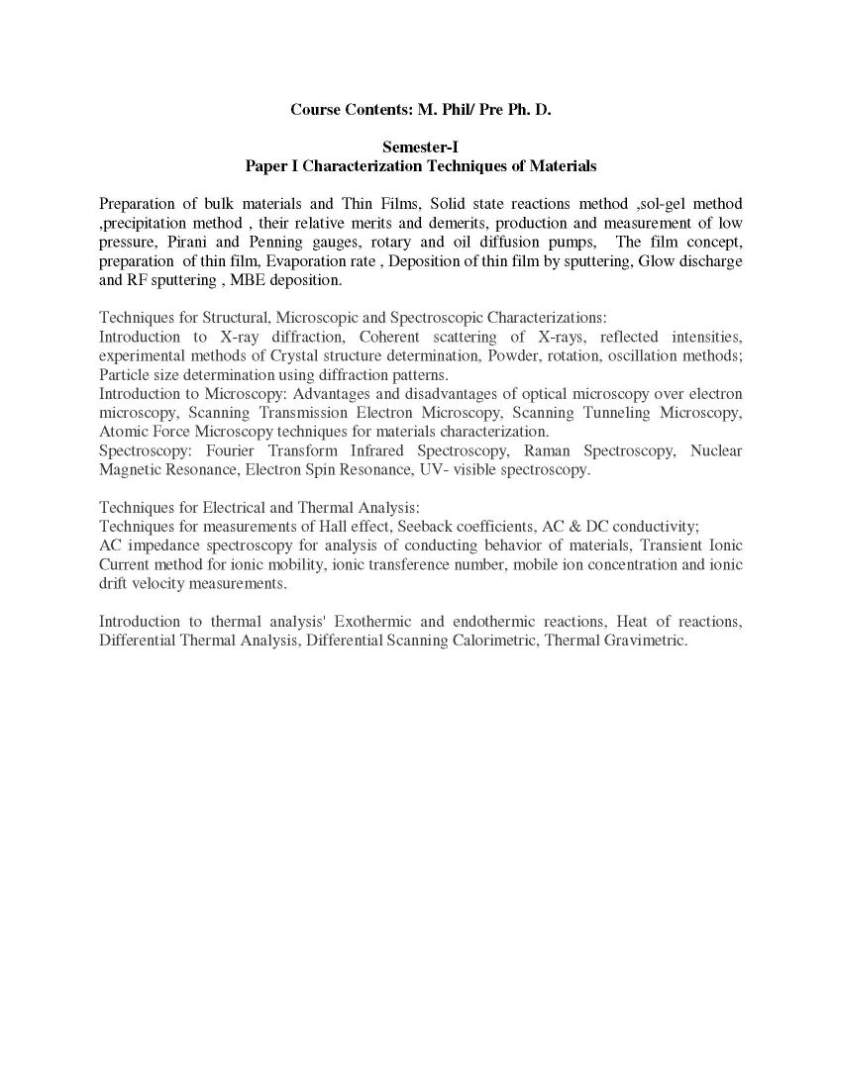|
#4
27th February 2015, 05:33 PM
| |||
| |||
| Re: Syllabus of Ph d In Guru Ghasidas University, Bilaspur
As you want I am here providing you Syllabus of M. Phil /Ph.D. Course Work of Pure & Applied Physics of Guru Ghasidas University, Bilaspur. Syllabus of M. Phil /Ph.D. Course Work: Semester-I Paper I Characterization Techniques of Materials Preparation of bulk materials and Thin Films, Solid state reactions method ,sol-gel method ,precipitation method , their relative merits and demerits, production and measurement of low pressure, Pirani and Penning gauges, rotary and oil diffusion pumps, The film concept, preparation of thin film, Evaporation rate , Deposition of thin film by sputtering, Glow discharge and RF sputtering , MBE deposition. Techniques for Structural, Microscopic and Spectroscopic Characterizations: Introduction to X-ray diffraction, Coherent scattering of X-rays, reflected intensities, experimental methods of Crystal structure determination, Powder, rotation, oscillation methods; Particle size determination using diffraction patterns. Introduction to Microscopy: Advantages and disadvantages of optical microscopy over electron microscopy, Scanning Transmission Electron Microscopy, Scanning Tunneling Microscopy, Atomic Force Microscopy techniques for materials characterization. Spectroscopy: Fourier Transform Infrared Spectroscopy, Raman Spectroscopy, Nuclear Magnetic Resonance, Electron Spin Resonance, UV- visible spectroscopy. Techniques for Electrical and Thermal Analysis: Techniques for measurements of Hall effect, Seeback coefficients, AC & DC conductivity; AC impedance spectroscopy for analysis of conducting behavior of materials, Transient Ionic Current method for ionic mobility, ionic transference number, mobile ion concentration and ionic drift velocity measurements. Introduction to thermal analysis' Exothermic and endothermic reactions, Heat of reactions, Differential Thermal Analysis, Differential Scanning Calorimetric, Thermal Gravimetric. Paper -II: PHYSICS OF ADVANCE MATERIALS Quantum Nanostructures and Nano Devices Quantum dots, wires and wells, preparation, size & dimensionality effects, excisions, single electron tunneling, applications of quantum nanostructures, exchange bias, self assembly, process of self assembly, semiconductor islands, mono layers, Catalysis, surface area of nano particles, porous and colloidal materials, Nano machines and nano devices: Micro electromechanical systems, Nano electromechanical systems NEMS’s Nano Particles and Nano Structural Materials: Properties of Individual Nano-particles, metal nano clusters, theoretical modeling of nano particles, magnetic clusters, semiconductor nanoparticles, optical properties, methods of synthesis of nano particles, Carbon nanostructures, carbon nanotube and applications. Bulk nano structured materials: solid disordered nanostructures, methods of synthesis, properties, metal nano-duster composite glasses, porous silicon, Nano structured crystals. Advanced Materials: Introduction, important characteristics and applications of advance materials, Linear and non linear dielectric materials, Ferroelectric, piezoelectric and electro-optic materials, composite materials, Liquid crystals, quasi-crystalline materials, hydride materials, PAPER – III: RESEARCH METHODOLOGY AND SCIENTIFIC PRESENTATION THEORY OF ERRORS Types of errors; mean deviation, standard deviation and probable errors; propagation of errors with summation, difference, product and quotient CURVE FITTING Curve fitting, Method of least square fit, least square fit (straight line) to linear equations and equation reducible to linear equations. Least Square fit (parabola) to quadratic equations and equations reducible to quadratic Equations. SCIENTIFIC PRESENTATION One seminar paper - preparation In power point (which include texts, graphs, pictures, tables, references etc.)(oral in power point/poster); development of communication skills in presentation of scientific seminars- eye to eye contact, facing to audience, question & answer sessions etc. ART OF SCJENTIFIC WRITING Steps to better writing, flow method, organization of material and style, drawing Figures, graphs, tables, footnotes, references ete. in a research paper. Here is the attachment. (syllabus of M. Phil/Ph.D. Course Work of Pure & Applied Physics of Guru Ghasidas University, Bilaspur)   |